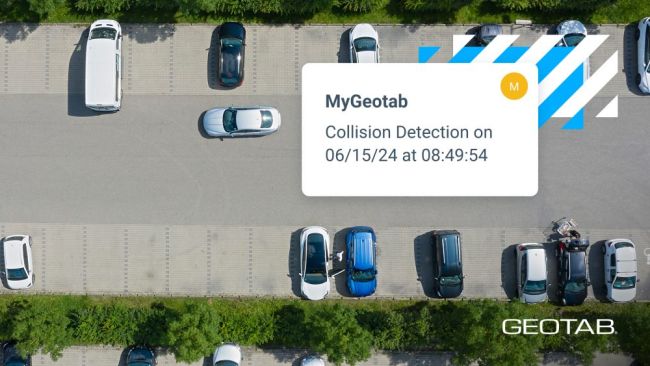
The Future of Telematics: Top Trends to Watch
Telematics data is among the most powerful fleet management tools. Fleet managers can use it to solve challenges, optimize operations, improve driver safety, reduce emissions and drive meaningful change across their business – all for the benefit of drivers, the public and the bottom line.
The telematics industry and the ways fleets use the data continually evolve. Keeping up on industry trends, including the following four, helps fleet managers make the most of their technology investment and magnify the benefits.
Trend 1: AI and Machine Learning Integration
One of the ways telematics providers are taking the technology to the next level is by employing artificial intelligence and machine learning to derive greater insights from the data.
AI is used to perform tasks that normally require human intelligence. In the context of fleet management, AI can take the massive amounts of data coming in from telematics devices and other sources, evaluate it and make decisions based on it.
Machine learning is the subset of AI that enables the system to learn and continually refine its interpretation of large data sets.
“While still on the horizon in terms of practical daily use, AI and machine learning have the potential to dramatically enhance the insight and analytics telematics provides,” said Frank Daccardi, manager of telematics solutions for Holman (www.holman.com), a fleet management solutions provider. “The effectiveness of any telematics program is determined by the speed at which you can effectively analyze data and implement change. AI can accelerate analytics, allowing you to act on the information much faster.”
AI and machine learning can be used for:
- Predictive maintenance: AI analyzes data patterns to forecast component failures before they occur, keeping vehicles operational, minimizing downtime and reducing costs.
- Smarter route optimization: Machine learning algorithms optimize routes and schedules based on historical and real-time data, aiding logistics, resource allocation, fuel use and customer service.
- Enhanced driver safety analytics: AI identifies risky driving behaviors and patterns that help fleet managers implement targeted safety interventions. Some telematics devices also provide spoken-word feedback to drivers for immediate coaching on high-risk behaviors.
“Geotab’s integration of AI and machine learning significantly enhances telematics capabilities, offering fleet managers powerful tools to optimize operations,” said Chris Jackson, associate vice president, business segment management, for telematics provider Geotab (www.geotab.com). “Together, these advanced technologies enable fleet managers to maintain higher levels of efficiency, reliability and safety in their operations.”
Trend 2: 5G Connectivity
“5G” refers to the fifth generation of wireless cellular network technology, which is designed to operate faster and more reliably than 4G networks.
“The advent of 5G connectivity will significantly impact telematics data transmission, enabling Geotab to offer fleet managers enhanced capabilities,” Jackson said. “This includes faster and more reliable data transfer, improving real-time tracking and monitoring. Fleet managers can make timely decisions based on up-to-the-minute information. Additionally, 5G improves communication between fleet managers and drivers, ensuring nearly instant transmission of instructions, updates and alerts, thus enhancing overall operational efficiency and responsiveness.”
While 5G has the potential to be a telematics game changer, Daccardi said the technology isn’t likely to make a widespread impact for several years.
“Vehicles and telematics units are cycled far less frequently than typical consumer goods and therefore often lag behind,” he explained. “That being said, 5G connectivity is likely to enable applications and use cases that simply aren’t feasible today partially due to speed/bandwidth limitations. For example, the video feed could not only be used to monitor driver performance but also potentially used to assess the progress of a particular job to help optimize scheduling, routing, et cetera.”
Trend 3: Enhanced Video Telematics and Driver Safety Features
The use of video telematics isn’t a new trend, but the technology continues to advance. What started with a single dashcam has expanded to include driver-facing and forward-facing in-cab cameras as well as those that provide 360-degree views around the vehicle. This technology helps fleets reduce accidents and liability.
“This technology essentially puts you in the vehicle with the driver,” Daccardi said. “Fleet operators can monitor drivers for high-risk behaviors like distracted driving, and many devices can even provide alerts or coaching to improve performance in near real time. Additionally, the footage captured by these units can help reduce liability for incidents when your driver is not at fault, providing valuable video evidence for potential litigation.”
Geotab has been working on enhancing integration with vehicle safety systems like advanced driver assistance systems (ADAS) and third-party safety solutions as well as new collision detection technology that detects and categorizes both major and minor incidents.
“Minor collisions often go unnoticed, but new technology enables fleet managers to perform maintenance, address safety issues and avoid downstream consequences,” Jackson said. “Accurate, near real-time collision detection enables quick responses; it helps expedite the claims process and identifies incident causes for preventive measures like driver training and route adjustments.”
Trend 4: An Increased Focus on Cybersecurity
As cybercrime gains prevalence, protecting sensitive data is a growing priority among organizations of all types. As a result, an enhanced focus on cybersecurity is a trend among telematics providers.
“Data security should be an important consideration as you select and implement your telematics solution,” Daccardi said. “Some telematics providers may only meet the minimum requirements to adhere to current regulations while others make data security a key pillar of their operating strategy.”
Jackson said Geotab implements robust measures to protect sensitive data and adhere to stringent compliance and protection standards to safeguard data integrity.
“Our end-to-end security approach includes employee training, device security and regular audits, allowing us to proactively protect data against new cyber threats,” he explained. “We follow rigorous protocols to safeguard client information and are trusted by many of the world’s most security-conscious organizations, including the General Services Administration.”
About the Author: Shelley Mika is the owner of Mika Ink, an Omaha, Nebraska-based branding and marketing communications agency. She has been writing about the fleet industry since 2006.

